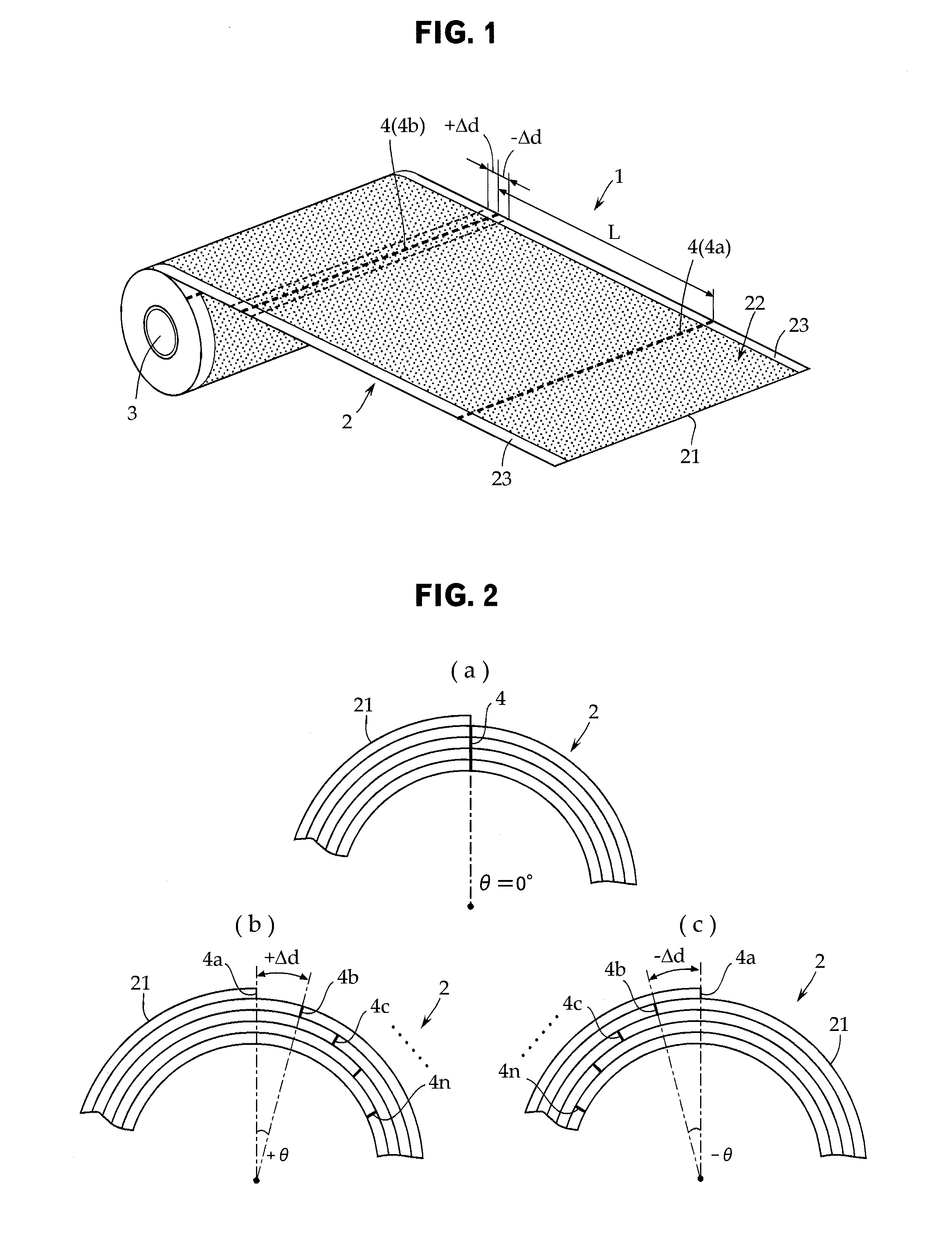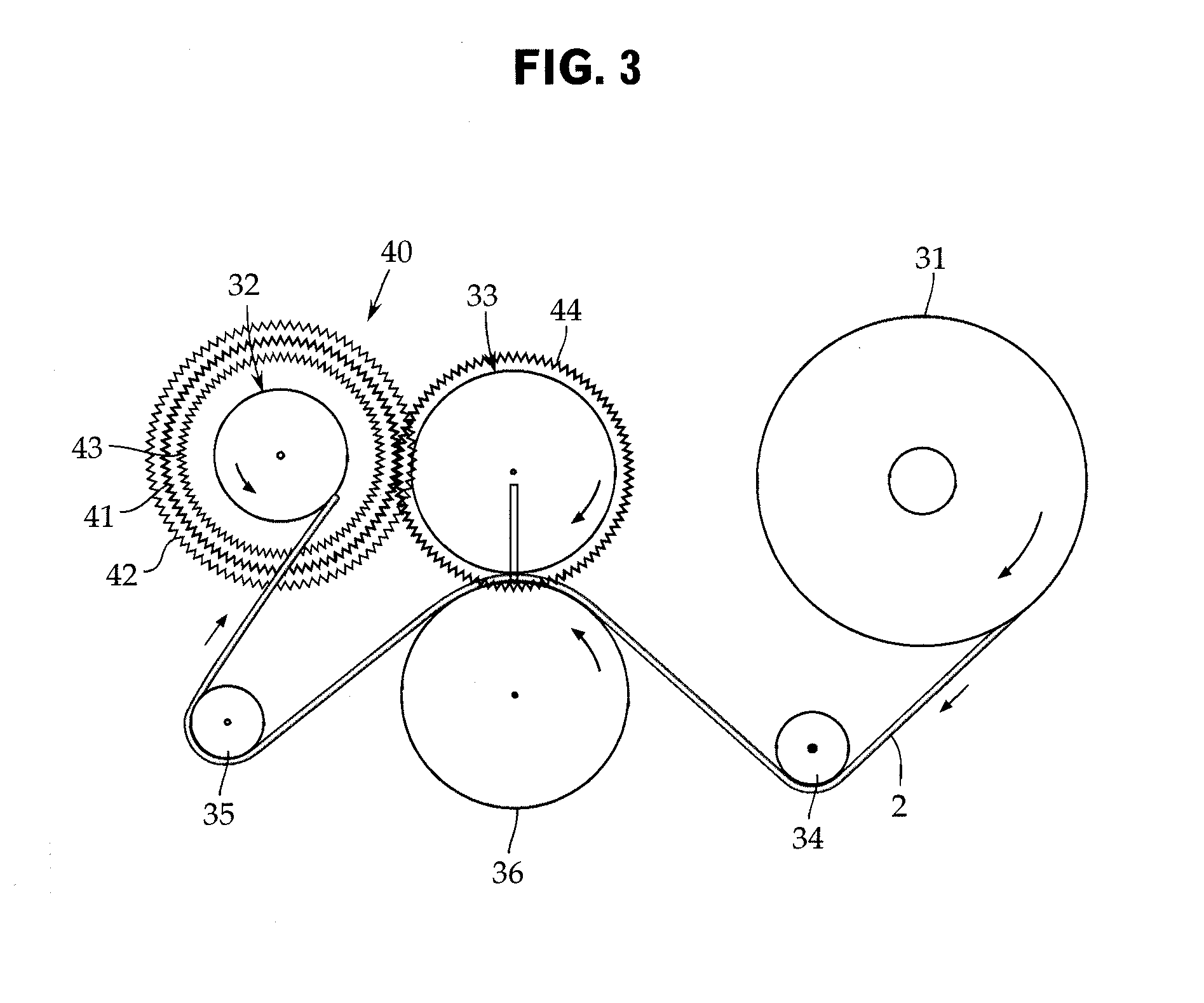[0011]In order to achieve the above object, the present invention has some features described below. The invention according to claim 1 provides a method for manufacturing an adhesive tape roll which is obtained by winding an adhesive tape having an adhesive face formed on one face of a substrate such that the adhesive face is directed to a front side and in which cut lines for
cutting are continuously formed in the adhesive tape at a predetermined interval along a feed direction of the adhesive tape, wherein a winding roller that winds the adhesive tape fed out from a mother roll and a cut-lines formation roller that is provided between the mother roll and the winding roller and forms the cut lines in the adhesive tape at the predetermined interval are provided, and the winding roller and the cut-lines formation roller are rotated in synchronization with each other via predetermined gears.
[0020]With the invention according to claim 2, a
gear ratio of a gear on a side of the winding roller to a gear on a side of the cut-lines formation roller is one to one. In this manner, cut lines can be regularly formed at the same position in an overlapped state. Therefore, the deformation of an adhesive tape roll into an onion shape can be reliably prevented.
[0021]With the invention according to claim 3, a
gear ratio of a gear on a side of the winding roller to a gear on a side of the cut-lines formation roller is less than one to one. In this manner, an interval between cut lines is set at a position greater than 360° on the basis of a circumferential length. Therefore, when a used adhesive face and a part of an adhesive tape including a boundary part are removed, an unused adhesive tape roll can be exposed over its whole circumference.
[0022]With the invention according to claim 4, a
gear ratio of a gear on a side of the winding roller to a gear on a side of the cut-lines formation roller is less than one to one. In this manner, an interval between cut lines is set at a position less than 360° on the basis of a circumferential length, and a previous used adhesive face remains at the tip end part of an unused adhesive tape face. Therefore, because adhesion at the tip end part of the unused adhesive tape face is reduced, a rail drawing phenomenon can be prevented.
[0023]With the invention according to claim 5, three types of gears having a gear ratio of one to one, less than one to one, and greater than one to one, respectively, are provided about one of the winding roller and the cut-lines formation roller and provided in such a manner as to be capable of selectively engaging with a gear of the other of the winding roller and the cut-lines formation roller. In this manner, three types of cut lines can be easily manufactured with a single apparatus.
[0024]With the invention according to claim 6, when a single circumferential length of the adhesive tape of an n-th (where n is a positive integer) turn is Ln, a
radius of the winding core is r, a thickness of the adhesive tape is t, a deviation between cut lines of an n-th layer and cut lines of an n+1-th layer is Δd, and an interval between the cut lines of the adhesive tape of the n-th turn and the cut lines of the n+1-th layer is expressed by an
angular difference θ, following Equations 1 to 3 are satisfied:
Ln=2π{r×(n−1)×t} Equation (1);
Ln+1=L×(360−θ) / 360 Equation (2); and
Ln+1=Ln+Δd Equation (3).
[0025]In this manner, cut lines can be arbitrarily formed at a predetermined interval on the condition that the
angular difference θ or the deviation Δd is made constant.
[0026]With the invention according to claim 7, the
angular difference θ is in a rage of equal to or greater than 6° and equal to or less than 19°. When the angular difference θ is less than 6°, the deviation Δd becomes equal to or less than 2 mm. Therefore, the reduction of adhesion cannot be prevented, which may cause a rail drawing phenomenon to occur. On the other hand, when the angular difference θ is greater than 19°, the deviation Δd becomes greater than 10 mm. Therefore, an unused adhesive tape must be wastefully torn off, which is economically disadvantageous.
 Login to View More
Login to View More  Login to View More
Login to View More 


